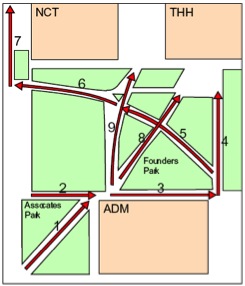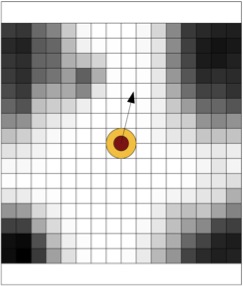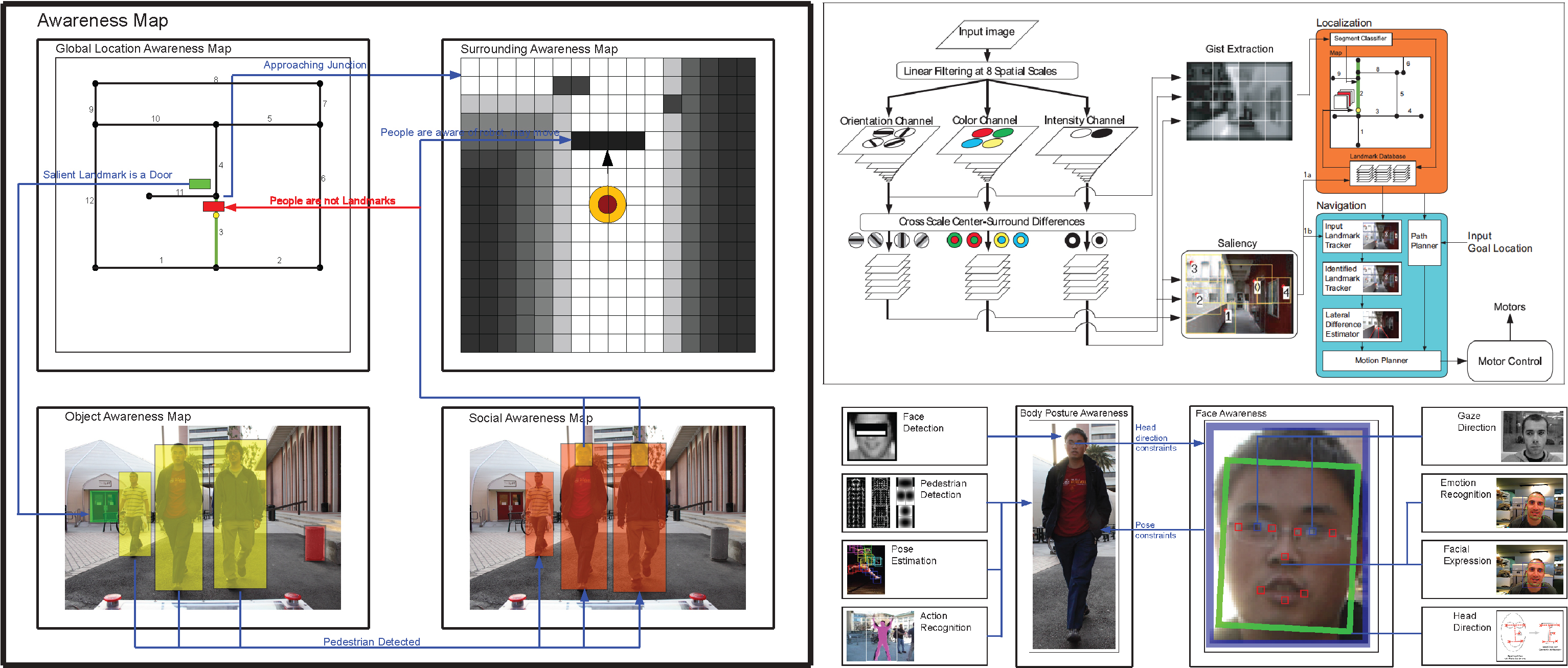This is an old revision of the document!
Table of Contents
The goal of the software system is to create an autonomous mobile robotic system that can perform robustly in the unconstrained outdoor environments, particularly in the urban environment where there are many people walking about. It consists of high level vision algorithms that try to solve problems in vision localization, navigation, object recognition, and Human-Robot Interaction (HRI).
All of Beobot2.0 software code is freely available in our Vision Toolkit, in particular in the : src/Robots/Beobot2.0/ folder. In the toolkit we also provide other software tools such as such as microcontroller code to run the robot.
Note that the first 2 sections (Deadlines and To Do) are ongoing internal message boards. The public section starts at the Current Research section.
Deadlines
Past software deadlines can be found here.
| Todo | Date | |
|---|---|---|
| 1. | AR 2012 paper submitted | July 31, 2013 |
| 2. | IEEE T-Robotics 2012 paper submitted | July 31, 2013 |
| 2. | Implement Human-Robot Interaction system | August 1, 2013 |
| 4. | Start crowded-scene related research | August 1, 2013 |
To Do
- IEEE TRobotics 2012: Hierarchical environment representation
- Global Localization: lifetime learning prior, GPS integration - local navigation map : BeoRoadFinder, IMU odometry
* ICRA2013: BeoRoadFinder: vision & planar LRF
- AR2012: Place recognition comparison
Hardware:
- encoder based movements: equalize motors, take out the battery capacity variability. Trim still ok.
- Sensor wrapper code: isWorking() and getData()
Current Research
The specific tasks that we are focusing on are:
- vision navigation system using salient regions. work notes.
- recognizing people and other target objects
- approaching and following people and other target objects
- real time human pose recognition and tracking that leads to better mobile Human Robot Interaction
Other projects:
- Vision based obstacle-avoidance emulating LGMD cells in locusts.
- Hierarchical Simultaneous Localization and Mapping
- Mobile robot exploration
Hierarchical Representation of the Robot's Environment
At the center of our software architecture is the use of hierarchical representation of the robot's environment. We have a two level map: a global map for localization (how to recognize one's own location) and a local map for localization (how to to move about one's current environment, regardless if we know our exact location).
The global map (illustrated by the left image) is a graph-based augmented topological map, which is very compact and scalable to localize large sized environments. On the other hand, for navigation, we utilize an ego-centric traditional grid occupancy map as local map (on the right), which details the dangers in the robot's immediate surrounding. Here the robot is denoted below by a circle with an arrow indicating the robot's heading.

 We find that it would be inefficient to use a grid map for global localization, as it is too large to maintain, but with little added information that a topological map cannot do.
We do not need to memorize every square foot of every hallway in the environment, we just need to know the one we are on.
By using a local map that will not be committed to the long term storage (it is robot-centric and is updated as the robot moves), we have our desired overall mobile robot representation that is both compact (for scalability) and detailed (for accuracy).
We find that it would be inefficient to use a grid map for global localization, as it is too large to maintain, but with little added information that a topological map cannot do.
We do not need to memorize every square foot of every hallway in the environment, we just need to know the one we are on.
By using a local map that will not be committed to the long term storage (it is robot-centric and is updated as the robot moves), we have our desired overall mobile robot representation that is both compact (for scalability) and detailed (for accuracy).
Software Tools
The following are the firmware level software that would be useful in optimizing robot systems:
Distributed Computer Communication
The Beobot2.0 software system uses ICE to communicate between computers in the cluster.
However, we would like to improve it and add tools that can evaluate how the individual modules are performing, or whether the network is congested by which data packets.
Distributed system features that are important:
- Performance optimization tools:
timers on modules (evolve, updateMessage) latency information of when the packets arrive The amount of data in the **network** to if it is **congested**
- Packet synchronization
* only evoke updateMessage if a set of packets with the **same index number** is received. * Be able to set the policy for packet dropping for individual message queues
All comes down to serialization.
Operating System
Real Time Robotics OS research at the kernel level down the line.
- Does not put too much priority in answering user inputs.
- Knows and Prioritize jobs that are the most critical to the survival of the robot.
- Can allocate resources properly to satisfy all the modules.
MOSIX and Scyld Beowulf operating systems that encapsulates all the individual nodes that does all the job distribution internally.
General notes to work your way around Mandriva 2009 and Ubuntu 9.10..
Back to Beobot 2.0
